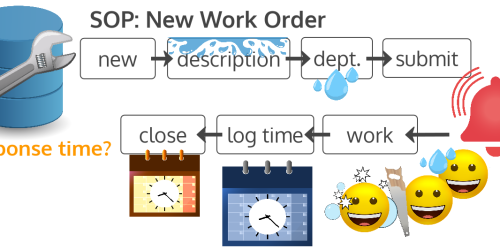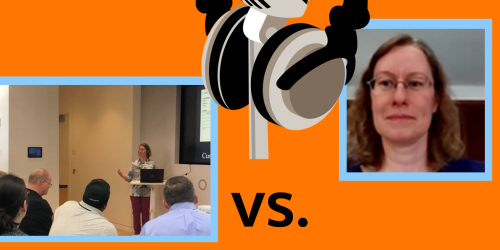Auditing your process improvement process | A SOP Story
TL;DR? Schedule some time to review the end results of the processes you’ve “improved,” and revise your current-day SOPs to incorporate back in anything you might have inadvertently “incrementally improved” out of your process along the way. Then again, you might just have an opportunity to pat yourself on the back for actually improving, and continue on! As a case study in this article, I draw from my own video production experience.
I’m a big believer in making incremental improvements, but sometimes an incremental change is actually an incremental deterioration.
That’s human. It’s easy to lose sight of your definition of success for a particular effort, not in terms of the net result of being able to say that success has been achieved, but rather in the way that the factors that you weigh for success are prioritized. In other words, I think of the success of most processes as a cluster concept, that is, there’s a list of criteria that should be met in order to be considered optimally successful, but I’ll still call an effort a success if:
- the high priority criteria have been met – these are the ones that, if they haven’t been met, the process is just an automatic fail (e.g., hard deadlines)
and
- a sufficient number of the other criteria have been met, or
- the criteria, both high priority and others, have been met sufficiently to say the end result is “ready to be shipped.”
The two sticky points are determining what’s going to count as sufficient, and what’s going to count as a high priority failure point. Because these assessments are usually more subjective and qualitative in nature, they can change without you realizing it. And inadvertently adjusting these bars can have a significant impact on your “successful” end result.
In my case, as my story below will show, I inadvertently deprioritized personality and presence in favor of a more efficient post-production process, and ended up in an exhausting cycle of chasing symptoms of the problem instead of addressing the root cause.
Defining Video Production Success Criteria
I want you, the reader, to be able to judge for yourself the validity of my claims and my solution, and so I’ll start by sharing my video production success criteria with you.
Don’t worry – I’m not about to bore you with the entire list. (My criteria are legion.) Instead, I’ll highlight the important ones that I’ve had since day one:
- Professional: These are business videos, and so I wanted to “look the part.” This entails a variety of subpoints about my clothes and my physical background, as well as some video technicalities like lighting and sound and a final product that reflects that I actually care about creating valuable content and spend time on planning and editing.
- Me: Part of what people like about me in person is that I’m “personable” and have a “friendly humor approach.” (I mentioned these already in another article on virtual presentations.) Even though I cover a relatively dry topic, I’m obviously bringing some sort of presence and personality to in-person moments, and I wanted that to carry through on video. Topic-wise, I also wanted the content to reflect the types of things I think about data and would bring to any experience of working with me, if that’s where these videos lead.
- Efficient and Scheduled: I’m a solopreneur, and I’m doing the entire process on my own every month. That means that I have to run a tight ship in terms of when I decide on the topic, when I write the script, when I record, when I send to my beta testers, when I make any final tweaks, when I upload and schedule publication on YouTube, when I clean up YouTube’s automatic captions, and when I write all the marketing blurbs that I’ll use to share the video on LinkedIn, my newsletter, and elsewhere. It’s easy to let content generation become a full-time job, especially when you enjoy it as much as I’ve enjoyed making most of my videos, so the scheduling and drive for efficiency keep me in check with respect to the line between working on and working in my business.
But right there, I had created a perfect storm of conflicting criteria that would eventually lead to my 12th video being a real slog. (Luckily, working on my 13th video would redeem the entire video effort and reset my process.)
The Symptoms of Incremental Deterioration
If you follow my LinkedIn feed at all, or you’re a member of the vidwheel Creator Network, you’re already aware that I’ve been in an ongoing (i.e., months-long) debate over the issue of smiles in my YouTube videos:
- smiles as a means of making a connection with my viewing audience,
- smiles as a means of helping people connect with certain content points,
- smiles as a means of imbuing my videos with personality and presence.
In May 2021, in the spirit of incremental improvements and in keeping with my success criterion of “Me,” I began working to incorporate more smiling. Some very vocal feedback said this was a missing part of the experience of “Me” in my videos versus other virtual interactions. And I could see their point – in working to perfect “Professional,” I had eroded some of the “Me.” So, smiles.
And that ended up being the proverbial straw that broke the camel’s back.
I had in fact been tweaking the “Me” criterion since day one. In my very first video, way back in August 2020, my camera setup and my own inclination to tilt my head back when I take a breath resulted in a lot of nostril shots that I deemed “unprofessional” after someone pointed it out to me. And so I started making my head angle a more conscious part of my recording process; it’s in fact part of the standard operating process/procedure (SOP) I review before recording so that it’s top of mind. Then, in November 2020, I was a guest on a podcast; viewing the recording made me really aware of how wiggly I am in my chair. And so sitting more still during recording as a means of incrementally improving on “Professional” also became a part of my video production SOP. As a byproduct, my post-production editing time was reduced, because my stillness made it much easier to cut things out without weird jumps in my video, which made me double-down on these decisions. Positive feedback regarding my “Professional” appearance made me triple-down.
But, on top of everything else, forcing myself to smile during videos, re-recording if I felt the first take wasn’t smiley enough….
it was downright physically exhausting.
In just two months of adding this to my cluster of success criteria, and making it a high priority based on feedback, I dreaded recording, and, as a precursor to recording, I struggled to write my scripts “on time.” I had started out really loving the process and the medium and my videos, and so I was keenly aware of my mood change around the process (as was everyone in my house). I seriously considered chucking video from my content generation schedule, but it was doing good things for my business, and so I was loath to drop it.
Certainly, by my criteria and priority system, each of the 12 videos produced to that point were a “success.” I decided to soldier on.
The 13th Video: An Awakening
Since I’m so process focused, I decided to revisit my first YouTube video as a means of exploring how my process had changed over the course of a year, and how doing that video “today” would be different. I had every expectation that the end result would be flat out “better” than the first version, due to all of those incremental improvements.
I started with my original script and original graphic selections, and tweaked from there to make it consistent with something I’d produce 12 months in. I have some general production goals I try to hit with every video now, like keeping my videos as close to under-five-minutes as possible, without sacrificing content. I also made other changes, like moving and modifying my call to action. So there were some generic constraints that influenced the new script in terms of my script template having changed.
But this is what was interesting…..
When I watched the first video again to see what I had done, just to refresh my memory, I had so much… PERSONALITY.
Yes, that was largely due to the adrenaline rush of recording my first video where I showed my face; I’m camera shy at the best of times, so this was far, far outside of my comfort zone. But then I watched my second video. I made jokes in that one, even while talking about the dry, dry topic of the nature of data. The “Me” in that video was me.
With some simple SOP changes geared towards incrementally improving on “Professional” and “Efficient and Scheduled,” I had actually eroded “Me.” I realized that the smiles feedback was highlighting a symptom, but the root cause was that I had deprioritized myself out of the video in favor of some post-production time and some “Professional” packaging concerns. In my search for incremental improvement, I was guilty of incremental deterioration.
I was shocked. And exhilarated! If I had actually discovered the true source of the “Me” problem, maybe I could reawaken the joy I had in creating the earlier videos!
And maybe I wouldn’t have to force myself to smile anymore! Woohoo!
In applying my new SOP to the old script, I created content that I liked more than the original. (Although I still like the original and am proud of it.) In getting rid of some of my pre-recording rituals and completely chucking my “Professional” and “Efficient and Scheduled” concerns over wiggling, the recording process was more pleasant. And I smiled and had my own personality without really having to think about it. Is the new video perfect? No. Is it a success? Yes. Is it more holistically successful than the 12th video? Yes. And that’s an incremental improvement.
What’s the Takeaway?
In the search for incremental improvement, it’s important to build in a periodic audit to check that you haven’t inadvertently put yourself on the path to incremental deterioration. It can be easy to prioritize easily trackable metrics like post-production efficiency time, and sometimes at the expense of the more qualitative side of the experience and end result. And sometimes you just need a reflective wake-up call and a course correction for success.
Here are my audit guidelines:
- Schedule these audits on a calendar. I did this one at the one-year mark, because I tend to do an annual “year in review” type of audit for just about everything in my business. I make little changes to my SOPs all of the time, so the year gap between reviews helps make the cumulative effect of the changes more obvious. That’s what works for me, but schedule according to what works for you.
- Where possible, use “evidence.”In this case, I had a pretty tangible work product I could review to see how the end result had changed over time. If that’s the case for you, too, use that as a means of exploring what you might have inadvertently incrementally deteriorated and what’s actually an incremental improvement.
- Use a decision log to keep track of reasons.I don’t keep a historical record of my SOPs, or do any kind of versioning. It’s one of the ways I prevent clutter in my file system. Instead, I keep a decision log to record for myself directional changes that get incorporated into my SOPs. Sometimes those things I flag as incremental deteriorations are there for a reason that hasn’t changed, and the decision log helps me remember that. In these cases, improvement will have to come from changing something else. If the change is big enough, it’s probably decision log worthy as well.
If you have your own way of auditing your processes, I’d love to hear about it in the comments! Everything is open for improvement, including my audit process. 😊 If you got something out of reading this SOP Story, I’d love a comment about that, too!






